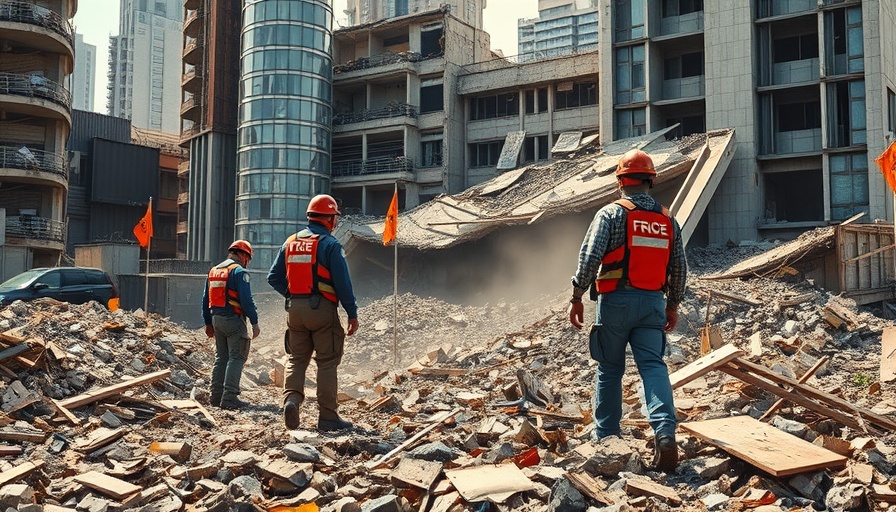
A Chilling Eyewitness Account of Myanmar's Earthquake
As devastating news continues to pour in about the earthquake that struck Myanmar on March 28, a heartbreaking account from a tourist has captured the world’s attention. Ravil Nasretdinov, witnessing the destruction firsthand in Mandalay, describes the trauma surrounding him as the earthquake rattled the nation. With a magnitude of 7.7, the event marked one of the most severe earthquakes the war-torn country has experienced in a century.
Nasretdinov speaks of the harrowing sight of collapsed high-rise buildings, and the desperate cries emanating from the wreckage. “At every step, I want to cry,” he shared, highlighting the immense emotional toll of such natural disasters. His account sheds light on the immediate fear and uncertainty that enveloped residents and tourists alike as they grappled with the aftermath and challenges of seeking safety.
The Rising Death Toll and Its Implications
In the wake of the earthquake, the human cost continues to mount, with reports indicating around 1,700 fatalities, 3,400 injuries, and over 300 individuals still unaccounted for. Facing overwhelming challenges, the Myanmar military government has called for international assistance—a rare move that reflects the critical situation on the ground. This urgent plea comes amid widespread criticism of the government’s handling of natural disasters and public welfare over the years.
The response to the earthquake has been swift from neighboring countries, with India, China, and Thailand deploying relief teams and materials. The sheer scale of devastation has triggered concern globally, particularly regarding Myanmar’s capacity to manage a disaster of this magnitude while battling ongoing political tensions and humanitarian crises.
What This Means for Myanmar’s Future
The earthquake not only exposes the physical vulnerabilities of Myanmar's infrastructure but also illuminates deeper systemic issues within the country. With hospitals already overwhelmed and basic resources in short supply, the disaster has underscored the ongoing inadequacies of government policies and emergency response frameworks. This presents a disconcerting challenge for a nation that is struggling to rebuild and recover from both natural occurrences and its own internal conflicts.
As Myanmar continues to face the dual burdens of a health crisis exacerbated by COVID-19 and the ongoing impacts of political instability, organizations and governments worldwide are urged to formulate a comprehensive response that considers long-term recovery and assistance for the most marginalized populations.
International Responses and Solidarity
Across the globe, the humanitarian community has rallied to assist, emphasizing the importance of solidarity during this desperate time. Aid groups are mobilizing resources and support to reach the hardest-hit areas, symbolizing a collective recognition of shared human vulnerability in the face of climate change and natural disasters.
The importance of international cooperation cannot be overstated as countries, organizations, and citizens come together to contribute to relief efforts. Innovative approaches that harness technology and collaborative frameworks can significantly enhance the effectiveness of the humanitarian response.
Resilient but Vulnerable: A Call for Reforms
Myanmar’s earthquake serves as a critical reminder of the need for reforms in infrastructure development, disaster preparedness, and governance. As nations assess the effectiveness of their policies in response to natural disasters, it becomes increasingly apparent that proactive measures are indispensable. Future enhancements in building codes and emergency response strategies will require the involvement of civil society and international partners to ensure that support reaches those who need it most.
This disaster has unmasked the fragilities within Myanmar and calls upon stakeholders to turn attention towards fostering resilience that will not only confront immediate crises but also prepare the nation for future challenges. The visitations from leaders and aid organizations can help establish a framework of governance that respects human rights and builds sustainable systems for support and recovery.
Conclusion: Moving Forward Together
As the world watches Myanmar wrestle with the aftermath of the earthquake, it is essential to leverage this moment as an opportunity for sustainable change. Addressing humanitarian needs must come hand-in-hand with advocating for broad reforms that respond to the societal complexities unique to Myanmar. The coming weeks and months will be crucial in determining the future trajectory of recovery, and it remains vital for the international community to remain engaged and responsive.
 Add Row
Add Row  Add
Add 




Write A Comment